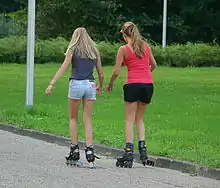Children's clothing
Children's clothing or kids' clothing is clothing for children who have not yet grown to full height. Children's clothing is often more casual than adult clothing, fit for play and rest.


More recently, however, a lot of childrenswear is heavily influenced by trends in adult fashion. Grandma bait is a retail industry term for expensive children's clothing.[1] Due to the rise of social media platforms such as Instagram, celebrities and fashion bloggers have been using their accounts to post pictures of their children wearing luxury "street style" clothing, thus inspiring parents to dress their children as they would dress themselves. Good quality, well designed garments are a priority for some parents, and children's clothing is getting a prime place in top-label stores and high-end fashion retail outlets. Dresses are also getting separately designed for boys and girls at a very early age.[2]
Function

Function and design must meet at the right proportions in children's clothes for it to be popular and accepted. Fabric choices, openings and fastenings, fit and ease, trimmings used are all major considerations when designing children's wear. Some other factors a designer designing for children's clothing should focus on are the changing shape of the growing kid and different proportions of the different parts of the body.
Leisure wear and sports wear are two very prominent design styles in children's clothing. Girls clothing are available in a wide range and styles. Children's clothing is also sometimes worn by adult midgets, dwarves or short people.[3]
Sizes
American sizes for baby clothes are usually based on the child's weight. European sizes are usually based on the child's height. These may be expressed as an estimated age of the child, e.g., size 6 months (or 3–6 months) is expected to fit a child 61 to 67 centimetres (24 to 26 in) in height and 5.7 to 7.5 kilograms (13 to 17 lb) in weight.[4]
Children's clothing and gender
More recently gender-specific children's clothing has become a contentious issue. According to some feminist thinkers, children's clothing has become increasingly segregated, with young girls especially being expected to wear pink. Peggy Orenstein writes in her book, Cinderella Ate My Daughter, that pink-coloured and princess-themed clothes are almost ubiquitous for young girls in shops in the United States. She sees this as problematic because it limits girls to not only one colour, but also to one spectrum of experience, and it "firmly fuses girls' identity to appearance."[5] According to Historian Jo B. Paoletti, pink and blue only became associated with girls and boys respectively from the 1940s onwards.[6][7]
In reaction to this situation, a campaign group Pinkstinks was formed in the UK in 2008[8] to raise awareness of what they claim is damage caused by gender stereotyping of children.[9] Further, clothing companies have started to sell clothes that are unisex or gender-neutral, such as Swedish companies Polarn O. Pyret,[10] while others have been founded specifically to offer such items, such as Tootsa MacGinty.[11][12]
References
- Horyn, Cathy (25 April 2012). "The Rise of Designer Children's Lines". The New York Times.
- Winifred, Aldrich (2011). Metric pattern cutting for children's wear and baby wear. Wiley.
- Gurel, Lois (1979). Dimensions of Dress and Adornment: A Book of Readings. p. 100.
- Size chart from Carter’s and OshKosh B’gosh
- Orenstein, Peggy Cinderella Ate My Daughter Harper Paperbacks, 2011, p.34
- Maglaty, Jeanne (April 8, 2011) When Did Girls Start Wearing Pink? smithsonianmag.com
- Paoletti, Jo Barraclough Pink and Blue: Telling the Boys from the Girls in America Indiana University Press, 2012
- Katy Guest (18 December 2011). "Girls will be girls: The battle for our children's hearts and minds this Christmas". The Independent. London. Retrieved 13 April 2013.
- Susanna Rustin (21 April 2012). "Why girls aren't pretty in pink". The Guardian. London. Retrieved 13 April 2013.
- Wade, Lisa (Aug 5, 2010) Why Not Gender Neutral Clothes thesocietypages.org
- (7 February 2012) Are we letting our little girls down by dressing them in pink? Wales Online
- Unisex fashion: Hey boy, hey girl The Independent
External links
- Fashion Plates of 19th & 20th Century Children's Clothing from The Metropolitan Museum of Art Libraries